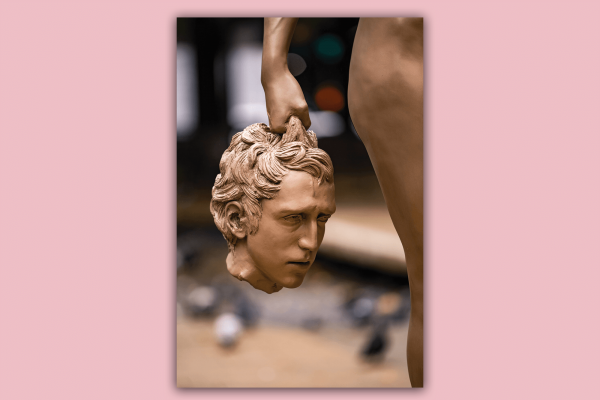IN THE GREEK mythology I was taught as a child, a recurring plot always struck me as deeply unfair. A god seduces—or rapes—a mortal woman, who either succumbs to the coercion or tries to resist. If she resists, she is punished. If she gives in, a jealous goddess punishes her.
The fact that my classmates and I had to read these myths without being encouraged to deconstruct them still disturbs me. My desire is not to sanitize art nor neuter its political incorrectness, but rather to see people (especially children) realize their agency as readers, particularly in instances where misogyny should be questioned. Which is why the installation of Luciano Garbati’s sculpture Medusa With the Head of Perseus in New York City represents a delightful inversion.
As the story goes, Medusa was a beautiful young woman, unfairly punished for being a victim of Poseidon’s lust. Because the rape takes place in Athena’s temple, Athena, believing her sanctuary defiled, turns Medusa into a monster. Medusa, now with snakes for hair, is so hideous that she can transform anyone who beholds her to stone. Perseus, a demigod himself, is tasked with killing Medusa, a duty he executes via beheading. A 16th-century bronze by Benvenuto Cellini, titled Perseus With the Head of Medusa, depicts Perseus in his moment of triumph. He holds Medusa’s head aloft while snakes emerge from her neck.
Garbati, an Argentine-Italian artist, reverses the tale by showing his Medusa victorious, sword in hand, fingers gripping Perseus’ head instead. His Medusa seeks to rectify a narrative injustice, but in its ambition has become a contentious symbol of the #MeToo movement, perhaps unfairly so.
Garbati’s critics have wondered why a woman wasn’t chosen to create the sculpture, or why Medusa doesn’t cut off Poseidon’s head—two lines of inquiry I entertained and ultimately discarded. Garbati simply submitted a proposal for the sculpture, rather than responding to a prompt for a specifically political work. Perhaps a similar proposal from a woman would not have been seen as equally radical, but there’s no way to know. To the second (more interesting) point, Garbati’s choice to depict Perseus’ death rather than Poseidon’s has all the markings of a grim, but apt, metaphor for how oppressive systems work. Poseidon certainly deserves punishment. A concrete image of his downfall would be satisfying. Yet, how often do we see an entire network of power dismantled by the removal of one person? Rarely, even if they are a god or Harvey Weinstein—or the president.
I write this in the final days of a contentious election, when an end to overt cruelty and mendaciousness glimmers at the edges of our collective vision. A new administration is in sight. But even when that happens, I am reminded that Perseus was merely a product of his society, an agent of various political forces. Though his death in Garbati’s Medusa might be justifiable in terms of Medusa’s immediate claim to self-defense, it does nothing to change a society that turns women into demons and sanctions unbridled male folly. That charge, it seems, rests with us.

Got something to say about what you're reading? We value your feedback!







